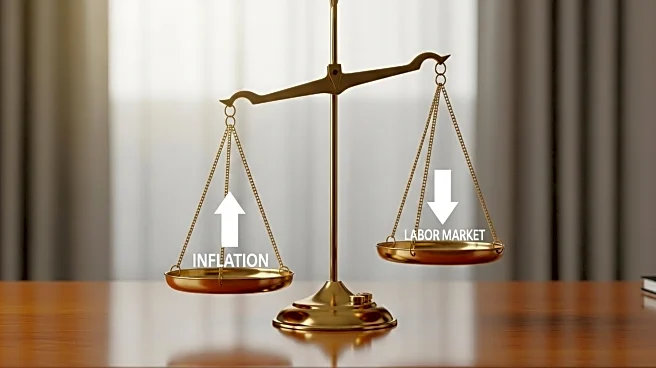What is the story about?
What's Happening?
The U.S. labor market is experiencing a significant slowdown, with August 2025 data showing a rise of only 22,000 nonfarm payroll jobs, far below the expected 75,000. The unemployment rate has increased to 4.3%, highlighting a cooling labor market. This slowdown is attributed to economic uncertainties under President Trump's tariff policies and geopolitical tensions. Key sectors like healthcare added jobs, but these were offset by losses in government, mining, and manufacturing. The weak job data has led to increased expectations for a Federal Reserve rate cut in September 2025, with financial markets pricing in a 90% probability of a 25-basis-point reduction. This anticipated dovish pivot by the Fed is crucial for equities and commodities, as lower rates typically boost growth stocks and inflation hedges like gold.
Why It's Important?
The potential Federal Reserve rate cut is significant for various stakeholders in the U.S. economy. Lower interest rates generally benefit growth sectors, particularly technology, by providing cheaper financing and boosting valuations. Cyclical sectors like small-cap industrials and consumer discretionary may also see gains due to improved financing conditions. Additionally, gold has surged 31% year-to-date, driven by its role as an inflation hedge amid declining real interest rates and a weakening U.S. dollar. Investors are adjusting portfolios to capitalize on these shifts, focusing on growth equities, intermediate-duration bonds, and commodities like gold. The rate cut could also impact the U.S. dollar, creating opportunities for non-U.S. investors to hedge against its decline.
What's Next?
As the Federal Reserve prepares for a potential rate cut, investors and financial markets will closely monitor the central bank's actions and statements. The anticipated rate cut could lead to further adjustments in investment strategies, with a focus on sectors that benefit from lower interest rates. Additionally, the weakening U.S. dollar may prompt international investors to adjust their exposure to U.S. equities. The broader economic implications of the rate cut, including its impact on inflation and fiscal policies, will also be key areas of focus for policymakers and market participants.
Beyond the Headlines
The anticipated rate cut by the Federal Reserve highlights deeper economic challenges, such as stagflationary pressures indicated by the narrowing spread between short-term and long-term Treasury yields. This economic environment poses risks of inflation without corresponding economic growth, complicating monetary policy decisions. The situation underscores the need for a balanced approach to fiscal and monetary policies to address both inflationary pressures and economic growth.
AI Generated Content
Do you find this article useful?














